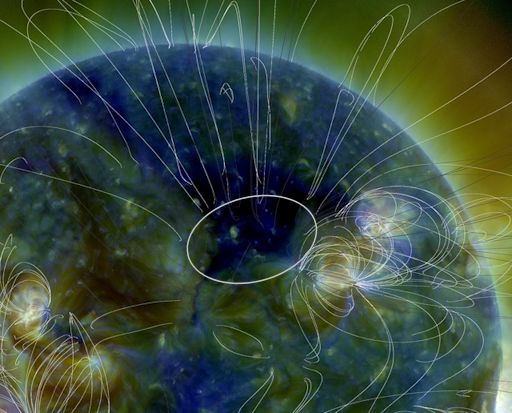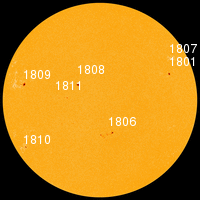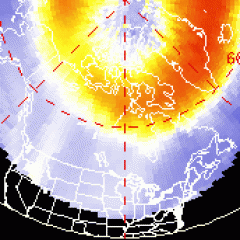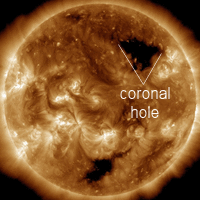Space Weather Update~ CORONAL HOLE [1]
SPACE WEATHER FACT CHECK: Many readers are asking about a report in the Washington Examiner [2], which states that a Carrington-class solar storm narrowly missed Earth two weeks ago. There was no Carrington-class [3] solar storm two weeks ago. On the contrary, solar activity was low throughout the month of July. The report is erroneous. The possibility of such a storm is, however, worth thinking about: A modern Carrington event would cause significant damage [4] to our high-tech society. Solar flare alerts: text [5], voice [6].
FIRST PERSEIDS OF 2013: Earth is entering a broad stream of debris from comet 109P/Swift-Tuttle, source of the annual Perseid meteor shower [7]. Although the shower won't peak until August 12-13, when Earth hits the densest part of the stream, the first Perseids are already arriving. "Despite poor weather over our network of meteor cameras [8], we detected three Perseid fireballs on July 30-31," reports Bill Cooke, head of NASA's Meteoroid Environment Office. He made this plot showing the orbits of the meteoroids:
In the diagram, the green lines trace the orbits of Perseid meteoroids. All three intersect Earth (the blue dot). The orbit of the parent comet is color-coded purple. An inset shows one of the fireballs shining almost as brightly as the Moon: video [10].
The shower is just getting started. Rates should remain low for the next week as Earth penetrates the sparse outskirts of the debris stream, then skyrocket to ~100 meteors per hour as the calendar turns to the second week of August. Stay tuned for more fireballs. [meteor radar [11]] [NASA: Perseid fireballs [12]].
Realtime Meteor Photo Gallery [13]
CORONAL HOLE: Magnetic fields in the sun's northern hemisphere have opened up, forming a coronal hole. This UV image from NASA's Solar Dynamics Observatory shows the opening as a dark gap in the sun's upper atmosphere:
Coronal holes are places in the sun's atmosphere where the magnetic field bends back and allows the solar wind to escape. A stream of solar wind flowing from this particular coronal hole will reach Earth on August 3-4. Its impact could spark a minor geomagnetic storm, so high-latitude sky watchers should be alert for auroras. Geomagnetic storm alerts: text [5], voice [6].
Another space weather fact check: News sources such as space.com and Fox News recently reported a "giant hole in the sun [15]." Fact: The "giant hole" was a fairly run-of-the-mill coronal hole, only slightly larger than usual. In defense of the journalists, their stories were prompted by a NASA report [16]. The report was accurate, but it showed a high-contrast image of the sun, which made the coronal hole look bigger and deeper than it actually was. An SDO image [17] taken at approximately the same time (July 18) shows the true scale of the hole.

Solar wind
speed: 328.2 km/sec
density: 2.3 protons/cm3
explanation [18] | more data [19]
Updated: Today at 1407 UT
X-ray Solar Flares
6-hr max: B9 1115 UT Aug02
24-hr: B9 1115 UT Aug02
explanation [20] | more data [21]
Updated: Today at: 1400 UT
![]()
Daily Sun: 02 Aug 13
None of these sunspots are actively flaring. Solar activity is low. Credit: SDO/HMI
![]()
Sunspot number: 88
What is the sunspot number? [23]
Updated 02 Aug 2013
Spotless Days
Current Stretch: 0 days
2013 total: 0 days (0%)
2012 total: 0 days (0%)
2011 total: 2 days (<1%)
2010 total: 51 days (14%)
2009 total: 260 days (71%)
Since 2004: 821 days
Typical Solar Min: 486 days
Update 02 Aug 2013
The Radio Sun
10.7 cm flux: 112 sfu
explanation [24] | more data [25]
Updated 02 Aug 2013
![]()
Current Auroral Oval:
Switch to: Europe, USA, New Zealand, Antarctica
Credit: NOAA/POES
![]()
Planetary K-index
Now: Kp= 1 quiet
24-hr max: Kp= 2 quiet
explanation [27] | more data [28]
Interplanetary Mag. Field
Btotal: 3.6 nT
Bz: 1.4 nT south
explanation [29] | more data [30]
Updated: Today at 1407 UT
![]()
Coronal Holes: 02 Aug 13
Solar wind flowing from this coronal hole could brush against Earth's magnetic field on August 3-4. Credit: SDO/AIA.




